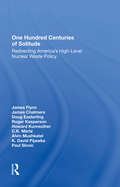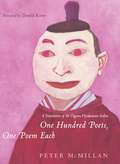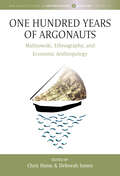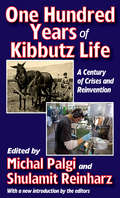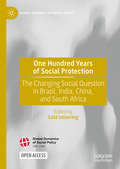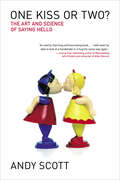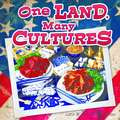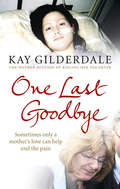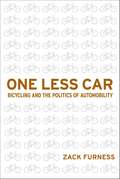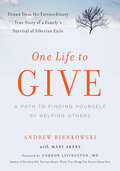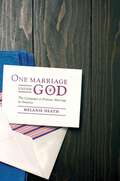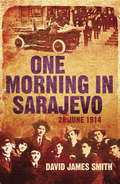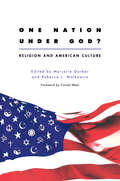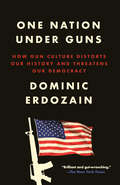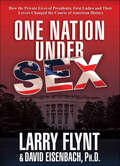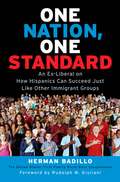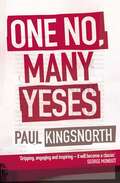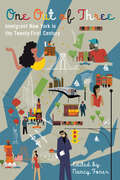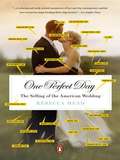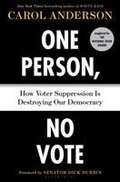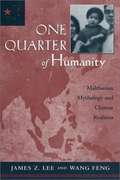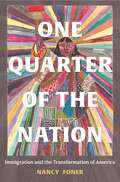- Table View
- List View
One Hundred Centuries Of Solitude: Redirecting America's High-level Nuclear Waste Policies
by Howard Kunreuther James Chalmers Roger Kasperson James Flynn Doug EasterlingTime is both the ally of high-level nuclear waste (HLNW) managers and the enemy. It is the ally because the radioactivity in elements and isotopes decreases with age, making the waste progressively less dangerous to human health and safety and the environment. This rate of radioactive decline varies, in some cases diminishing by half (the half life) in seconds, minutes, hours, days, weeks, months, or years. In other cases the decay process takes centuries or hundreds of thousands of years before the wastes are safe for human contact. The problem as now conceptualized for HLNW managers is simple to state if not easy to achieve. The HLNW needs to be secured in some fashion until it decays, by virtue of its physical nature, to safe levels. Another possible future solution, not currently available, might be to change the ~~ructure of HLNW through high-technology processing and thus decompose the waste into units with different and less lengthy radioactivity. Learning whether this processing is a future option will require patience and generous amounts of time for research.
One Hundred Poets, One Poem Each: A Translation of the Ogura Hyakunin Isshu
by Peter McmillanCompiled in the thirteenth century, the Ogura Hyakunin Isshu is one of Japan's most quoted and illustrated works, as influential to the development of Japanese literary traditions as The Tale of Genji and The Tales of Ise. The text is an anthology of one hundred waka poems, each written by a different poet from the seventh century to the middle of the thirteenth, which is when Fujiwara no Teika, a renowned poet and scholar, assembled and edited the collection. The book features poems by high-ranking court officials and members of the imperial family, and each is composed in the waka form of five lines with five syllables in the first and third lines and seven syllables in the second, fourth, and fifth ( waka is a precursor of haiku). Despite their similarity in composition, these poems evoke a wide range of emotions and imagery, and touch on themes as varied as frost settling on a bridge of magpie wings to the continuity of the imperial line. Though the Ogura Hyakunin Isshu has been translated into English before, many scholars and other translators have struggled with the formality of the original text, often padding lines in order to conform to the original syllabic model or rearranging the poems to create unnecessary rhyme. In this bold new translation, Peter McMillan uses only the words that are necessary to evoke the original sensations these poems once gave their readers. The poems are accompanied by calligraphic versions in Japanese and line drawings of the individual poets. Explanatory notes place the poems in context, and an appendix includes both the poems' Japanese typed and romanized versions. The Ogura Hyakunin Isshu is an excellent introduction to Japan and its special lyric tradition.
One Hundred Years of Argonauts: Malinowski, Ethnography and Economic Anthropology (Max Planck Studies in Anthropology and Economy #13)
by Deborah James Chris HannMalinowski’s Argonauts of the Western Pacific was a major contribution to anthropological theory and method, while simultaneously establishing the sub-field of economic anthropology. Even a century after its publication, Malinowski’s pioneering work remains critical for anthropology in a postcolonial age. This volume uses ethnographic studies from around the world to contextualize the work politically and intellectually, examining its gestation and influence from multiple perspectives. It critically explores the meaning of “economy” for Malinowski from his formation in the Austro-Hungarian Empire to his path-breaking fieldwork in Melanesia and ensuing career in London.
One Hundred Years of Kibbutz Life: A Century of Crises and Reinvention
by Michal PalgiOne Hundred Years of Kibbutz Life shows that the kibbutz thrives and describes changes that have occurred within Israel's kibbutz community. The kibbutz population has increased in terms of demography and capital, a point frequently overlooked in debates regarding viability. Like the kibbutz founders who established a society grounded in certain principles and meeting certain goals, kibbutz newcomers seek to build an idealistic society with specific social and economic arrangements.The years 1909-2009 marked a century of kibbutz life one hundred years of achievements, challenges, and creative changes. The impact of kibbutzim on Israeli society has been substantial but is now waning. While kibbutzim have become less relevant in Israeli policy and politics, they are increasingly engaged in questions of environmentalism, education, and profitable industries.Contributors discuss the hopes, goals, frustrations, and disappointments of the kibbutz movement. They also examine reform efforts intended to revitalize the institution and reinforce fading kibbutz ideals. Such solutions are not always popular among kibbutz members, but they demonstrate that the kibbutz is an adaptive and flexible social organization. The various studies presented in this book clarify the dynamism of the kibbutz institution and raises questions about the ways in which residential arrangements throughout the world manage change.
One Hundred Years of Social Protection: The Changing Social Question in Brazil, India, China, and South Africa (Global Dynamics of Social Policy)
by Lutz LeiseringWhile the rise of social protection in the global North has been widely researched, we know little about the history of social protection in the global South. This volume investigates the experiences of four middle-income countries - Brazil, India, China and South Africa - from 1920 to 2020, analysing if, when, and how these countries articulated a concern about social issues and social cohesion. As the first in-depth study of the ideational foundations of social protection policies and programmes in these four countries, the contributions demonstrate that the social question was articulated in an increasingly inclusive way. The contributions identify the ideas, beliefs, and visions that underpinned the movement towards inclusion and social peace as well as counteracting doctrines. Drawing on perspectives from the sociology of knowledge, grounded theory, historiography, discourse analysis, and process tracing, the volume will be of interest to scholars across political science, sociology, political economy, history, area studies, and global studies, as well as development experts and policymakers.
One Kiss or Two?: The Art and Science of Saying Hello
by Andy Scott&“[An] enlightening survey of greeting customs from around the world . . . [a] breezy mix of pop sociology, personal anecdote, and self-help.&” —Publishers Weekly Humans have been greeting each other for thousands of years. It should be the most straightforward thing in the world, but this seemingly simple act is fraught with complications, leading to awkward misunderstandings, intercultural fumblings, and social gaffes that can potentially fracture relationships forever. Why is that? Why are greetings so important? Is there a right and wrong way to say hello? In his illuminating book One Kiss or Two?, Andy Scott—a well-traveled former diplomat and no stranger to botched first contacts himself—takes a closer look at what greetings are all about. In discovering how they have developed over human history, he uncovers a kaleidoscopic world of etiquette, body-language, evolution, neuroscience, anthropology, and history. Through in-depth research and his personal experiences, and with the help of experts ranging from the world-famous primatologist Jane Goodall to the leading sociologist of the twentieth century Erving Goffman, Scott takes readers on a captivating journey through a subject far richer than we might have expected. By the end of it, we are able to make more sense of what lies behind greetings—and what it means to be human in the modern, cross-cultural age. &“Scott speculates on the origins of the cheek-kissing tradition . . . and how to avoid a social faux pas no matter where you are.&” —Conde Nast Traveler &“An utterly charming and fascinating book. I will never be able to look at a handshake or a hug the same way again.&” —Joshua Foer, New York Times–bestselling author
One Land, Many Cultures
by Maureen Picard RobinsThis Title Addresses How America Is A Melting Pot Filled With People From All Over The World. Learning About Their Native Language, The Foods They Eat, And Their Customs Are Just Some Of The Issues Addressed In This Book. Maps That Show The Different Parts Of The World Where Their Ancestors Came From Are An Added Feature.
One Last Goodbye: Sometimes only a mother's love can help end the pain
by Kay GilderdaleWatching her child die is the hardest thing a mother can ever do. But for Kay Gilderdale, saying a final goodbye to her only daughter Lynn was exceptionally painful: she'd played a part in her death.Lynn was just 14 when she was struck down by the crippling disease ME, leaving her paralysed and in constant agony. Over the next 17 years, she became desperate to escape her miserable existence, even begging her mum to help her die. So, one night, when Kay found Lynn attempting suicide, she was forced to make an impossible decision. Continue watching her child suffer or help her end the pain?Eventually, fighting her every instinct, Kay helped her precious daughter take a fatal overdose. But while Lynn was finally free, her mother faced a fresh agony - a possible lifetime behind bars. The highly controversial trial that followed opened a fierce public debate on assisted suicide. Is it murder or mercy?Here, in her heartbreaking story, Kay reveals the harrowing truth behind the headlines and the desperate lengths a mother will go to for the love of a child.
One Less Car: Bicycling and the Politics of Automobility
by Zack FurnessAlthough millions of people in the United States love to ride bicycles for exercise or leisure, statistics show that only 1% of the total U. S. population ride bicycles for transportation—and barely half as many use bikes to commute to work. In his original and exciting book, One Less Car, Zack Furness examines what it means historically, culturally, socioeconomically, and politically to be a bicycle transportation advocate/activist. Presenting an underground subculture of bike enthusiasts who aggressively resist car culture, Furness maps out the cultural trajectories between mobility, technology, urban space and everyday life. He connects bicycling to radical politics, public demonstrations, alternative media production (e. g. , ‘zines), as well as to the development of community programs throughout the world. One Less Caralso positions the bicycle as an object with which to analyze and critique some of the dominant cultural and political formations in the U. S. —and even breaks down barriers of race, class and gender privilege that are interconnected to mobility. For Furness, bicycles not only liberate people from technology, they also support social and environmental justice. So, he asks, Why aren’t more Americans adopting them for their transportation needs?
One Life to Give: A Path To Finding Yourself By Helping Others
by Andrew BienkowskiFind Yourself by Helping Others—Life Lessons from an Extraordinary Story of Sacrifice and Survival In the winter of 1939, five-year-old Andrew Bienkowski was exiled to Siberia with his family. The two years of struggle that followed—especially his grandfather’s amazing act of sacrifice during their first long, cold winter—have informed the rest of Andrew’s life. Thanks to his devoted mother, his quick-witted grandmother, and the unexpected kindness of strangers, Andrew established an approach to life that emphasizes helping others as the essential path to finding our greatest human fulfillment.
One Marriage Under God: The Campaign to Promote Marriage in America (Intersections #16)
by Melanie HeathThe meaning and significance of the institution of marriage has engendered angry and boisterous battles across the United States. While the efforts of lesbians and gay men to make marriage accessible to same-sex couples have seen increasing success, these initiatives have sparked a backlash as campaigns are waged to “protect” heterosexual marriage in America. Less in the public eye is government legislation that embraces the idea of marriage promotion as a necessary societal good. In this timely and extensive study of marriage politics, Melanie Heath uncovers broad cultural anxieties that fuel on-the-ground practices to reinforce a boundary of heterosexual marriage, questioning why marriage has become an issue of pervasive national preoccupation and anxiety, and explores the impact of policies that seek to reinstitutionalize heterosexual marriage in American society. From marriage workshops for the general public to relationship classes for welfare recipients to marriage education in high school classrooms, One Marriage Under God documents in meticulous detail the inner workings of ideologies of gender and heterosexuality in the practice of marriage promotion to fortify a concept of “one marriage,” an Anglo-American ideal of Christian, heterosexual monogamy.
One More River to Cross: Black and Gay in America, First Edition
by Keith BoykinIn organizing the 1993 March on Washington for gay and lesbian rights, leaders of the gay community consciously paralleled Martin Luther King's historic 1963 March on Washington and proclaimed their mission was "a simple matter of justice." In response, black leaders and ministers across the country challenged any comparison between blacks and gays as offensive and irrational. In One More River to Cross, Keith Boykin clarifies the relationship between blacks and gays in America by portraying the "common ground" lives of those who are both black and gay. <P><P>Against a historical backdrop of civil rights and the black experience in America, Boykin interviews Baptist ministers, gay political leaders, and other black gays and lesbians on issues of faith, family, discrimination, and visibility to determine what differences-- real and imagined-- separate the two communities. Boykin points to evidence of African and precolonial same-sex behavior, as well as figures like James Baldwin and Bayard Rustin, to dispel the myth that homosexuality is a "white thang," while his research suggests that blacks are less homophobic than whites, despite the rhetoric of rap and religion. With stories from his own experience as well as that of other black gays and lesbians, Boykin targets gay racism and black homophobia and suggests that conservative forces have substituted the common language of racism for homophobia in order to prevent a potentially powerful coalition of blacks and gays. <P><P>By portraying what it means to be black and gay in America, One More River to Cross offers an extraordinary window into a community that challenges this country's acceptance of its minorities, both racial and sexual.
One Morning In Sarajevo: The true story of the assassination that changed the world
by David James SmithSarajevo, 28 June 1914: The story of the assassination that changed the world.A historical account of the assassination of Archduke Franz Ferdinand. Using newly available sources and older material, David James Smith brilliantly reinvestigates and reconstructs the events which subsequently determined the shape of the twentieth century.Young Gavrilo Princip arrived at the Vlajnic pastry shop in Sarajevo in Bosnia-Herzegovina on the morning of 28 June 1914. He was greeted by his fellow conspirators in the plot to kill Archduke Franz Ferdinand. The Archduke, next in line to succeed as Emperor of Austria, was beginning a state visit to Sarajevo later that morning. Ferdinand was not a very popular character - widely thought of as bad-tempered and arrogant and perhaps even deranged. To the young students he embodied everything they loathed about imperial oppression. They planned to kill him at about 11 o'clock as he paraded down Appel Quay to the town hall in his open top car.What happened in those few hours - leading as it did to the First and Second World Wars - is as compelling as any thriller.
One Nation Under God?: Religion and American Culture (CultureWork: A Book Series from the Center for Literacy and Cultural Studies at Harvard)
by Marjorie Garber Rebecca L. WalkowitzOne Nation Under God? is a remarkable consideration of how religion manifests itself in America today.
One Nation Under Guns: How Gun Culture Distorts Our History and Threatens Our Democracy
by Dominic ErdozainThis takedown of American gun culture argues that the nation&’s founders did not intend the Second Amendment to guarantee an individual right to bear arms—and that this distortion of the record is an urgent threat to democracy.&“At once eye-opening and enraging, One Nation Under Guns is that rare book that can help change the way we live in this country.&”—Eddie S. Glaude Jr., bestselling author of Begin AgainMore than a hundred lives are lost to firearms every day in America. The cost is more than the numbers—it is the fear, the anxiety, the dread of public spaces that an armed society has created under the tortured rubric of freedom. But the norms of today are not the norms of American history or the values of its founders. They are the product of a gun culture that has imposed its vision on a sleeping nation.Historian Dominic Erdozain argues that we have wrongly ceded the big-picture argument on guns: As we parse legislation on background checks and automatic-weapons bans, we fail to ask what place guns should have in a functioning democracy. Taking readers on a brilliant historical journey, Erdozain shows how the founders feared the tyranny of individuals as much as the tyranny of kings—the idea that any person had a right to walk around armed was anathema to their notion of freedom and the peaceful republic they hoped to build. They wrote these ideas into the Constitution and the Bill of Rights, ideas that were subsequently affirmed by two centuries of jurisprudence.And yet the twin scourges of racism and nationalism would combine to create a darker American vision—a rogue and reckless freedom based on birth and blood. It was this freedom, not the liberty promised by the Constitution, that generated our modern gun culture, with its mystic conceptions of good guys and bad guys, innocence and guilt. By the time the U.S. Supreme Court reinvented the Second Amendment in 2008&’s District of Columbia v. Heller, an opinion that Erdozain convincingly eviscerates, many Americans had already acceded to the fiction: the unfreedom of an armed society. To save our democracy, he argues, we must fight for the founders&’ true idea of what it means to be free.
One Nation Under Sex: How the Private Lives of Presidents, First Ladies and Their Lovers Changed the Course of American History
by David Eisenbach Larry Flynt“Americans often like to think that extramarital sex—or even a strong libido—is somehow a sign of poor character in our presidents. One Nation Under Sex explodes that myth...You don’t have to agree with all of Larry Flynt’s and David Eisenbach’s readings of history to enjoy this sex-filled tour through more than 200 years of scandal.”—David Greenberg, author of Republic of Spin: An Inside History of the American PresidencyBen Franklin saved the American Revolution by seducing French Women. A gay love affair between President James Buchanan and Senator William King aided the secession movement. Woodrow Wilson’s girlfriend dictated his letters to the German Kaiser. And lesbian relationships inspired Eleanor Roosevelt to become a revolutionary crusader for equal rights. The colorful sex lives of America’s most powerful leaders have influenced social movements, government policies, elections and even wars, yet they are so whitewashed by historians that people think Thomas Jefferson and Abe Lincoln were made of marble, not flesh and blood.But the truth is about to come out. In One Nation Under Sex, free speech activist and notorious Hustler magazine publisher Larry Flynt teams up with Columbia University history professor David Eisenbach to peek behind the White House bedroom curtains and document how hidden passions have shaped public life. They unpack salacious rumors and outright scandals, showing how private affairs have driven pivotal decisions—often with horrific consequences. Along the way, they explore the origins of America’s fascination with sex scandals and explain how we can put aside out political moralism and begin focusing on the real problems that threaten our nation.
One Nation, One Standard
by Herman BadilloWhy aren't Hispanics succeeding like Asians, Jews, and other immigrant groups in America? Herman Badillo's answer is as politically incorrect as the question: Hispanics simply don't put the same emphasis on education as other immigrant groups. As the nation's first Puerto Rican-born U. S. congressman, the trailblazing Badillo once supported bilingual education and other government programs he thought would help the Hispanic community. But he came to see that the real path to prosperity, political unity, and the American mainstream is self-reliance, not big government. Now Badillo is a champion of one standard of achievement for all races and ethnicities. In this surprising and controversial manifesto, you will learn:* Why Hispanic culture's trouble with education, democracy, and economics stems from Mother Spain and the "five-hundred year siesta" she induced in Latin America. * Why the Congressman who drafted the first Spanish-English bilingual education legislation now believes that bilingual education hurts students more than it helps. * Why "social promotion" - putting minority students' self-esteem ahead of their academic performance and then admitting them to college unprepared - continues to this day, despite the system's documented failures and injustices. * How self-identifying as "Hispanic" or "white" or "black" undermines achievement, and what lessons we can learn from Latin American countries, where one's race is irrelevant. With Central and Latin America exporting a large portion of their poor, Hispanics are on the way to becoming a majority in the United States. . . but one with all the problems of a minority culture. Badillo's solution to this problem relies on traditional values: hard work, education, and achievement. His lessons are important not only for Hispanics but for every American.
One Nation, One Standard
by Herman BadilloWhy aren't Hispanics succeeding like Asians, Jews, and other immigrant groups in America? Herman Badillo's answer is as politically incorrect as the question: Hispanics simply don't put the same emphasis on education as other immigrant groups. As the nation's first Puerto Rican-born U.S. congressman, the trailblazing Badillo once supported bilingual education and other government programs he thought would help the Hispanic community. But he came to see that the real path to prosperity, political unity, and the American mainstream is self-reliance, not big government. Now Badillo is a champion of one standard of achievement for all races and ethnicities. In this surprising and controversial manifesto, you will learn: Why Hispanic culture's trouble with education, democracy, and economics stems from Mother Spain and the "five-hundred year siesta" she induced in Latin America. Why the Congressman who drafted the first Spanish-English bilingual education legislation now believes that bilingual education hurts students more than it helps. Why "social promotion" -- putting minority students' self-esteem ahead of their academic performance and then admitting them to college unprepared -- continues to this day, despite the system's documented failures and injustices. How self-identifying as "Hispanic" or "white" or "black" undermines achievement, and what lessons we can learn from Latin American countries, where one's race is irrelevant. With Central and Latin America exporting a large portion of their poor, Hispanics are on the way to becoming a majority in the United States... but one with all the problems of a minority culture. Badillo's solution to this problem relies on traditional values: hard work, education, and achievement. His lessons are important not only for Hispanics but for every American.
One No, Many Yeses
by Paul KingsnorthThe Global Resistance Movement is one of the 21st century’s most active and influential organizations. It is a global coalition of millions united in resisting and building alternatives to an out-of-control global economy. It emerged in Mexico in 1994 when the Zapatista rebels rose up in defiance of the North American Free Trade Agreement. The West first noticed it in Seattle in 1999 when the World Trade Organization was stopped in its tracks by 50,000 protesters. More significantly, the anti-capitalist street protests are only the tip of its iceberg. It aims to shake the foundations of the global economy and change the course of history. But what exactly is it? Who is involved, what do they want, and how do they aim to get it? To find out, Paul Kingsnorth traveled across four continents to visit some of the epicenters of the movement. In the process, he was tear-gassed on the streets of Genoa; painted anti-WTO puppets in Johannesburg; met a tribal guerrilla with supernatural powers; took a hot bath in Arizona with a pie-throwing anarchist; and infiltrated the world's biggest gold mine in New Guinea. Along the way, he found a new political movement and a new political idea. It is united in what it opposes and deliberately diverse in what it wants instead.
One Out of Three: Immigrant New York in the Twenty-First Century
by Nancy FonerThis absorbing anthology features in-depth portraits of diverse ethnic populations, revealing the surprising new realities of immigrant life in twenty-first-century New York City. Contributors show how nearly fifty years of massive inflows have transformed New York City's economic and cultural life and how the city has changed the lives of immigrant newcomers.Nancy Foner's introduction describes New York's role as a special gateway to America. Subsequent essays focus on the Chinese, Dominicans, Jamaicans, Koreans, Liberians, Mexicans, and Jews from the former Soviet Union now present in the city and fueling its population growth. They discuss both the large numbers of undocumented Mexicans living in legal limbo and the new, flourishing community organizations offering them opportunities for advancement. They recount the experiences of Liberians fleeing a war torn country and their creation of a vibrant neighborhood on Staten Island's North Shore. Through engaging, empathetic portraits, contributors consider changing Korean-owned businesses and Chinese Americans' increased representation in New York City politics, among other achievements and social and cultural challenges. A concluding chapter follows the prospects of the U.S.-born children of immigrants as they make their way in New York City.
One Perfect Day
by Rebecca MeadAstutely observed and deftly witty, One Perfect Day masterfully mixes investigative journalism and social commentary to explore the workings of the wedding industry?an industry that claims to be worth $160 billion to the U. S. economy and which has every interest in ensuring that the American wedding becomes ever more lavish and complex. Taking us inside the workings of the wedding industry?including the swelling ranks of professional event planners, department stores with their online registries, the retailers and manufacturers of bridal gowns, and the Walt Disney Company and its Fairy Tale Weddings program?New Yorker writer Rebecca Mead skillfully holds the mirror up to the bride?s deepest hopes and fears about her wedding day, revealing that for better or worse, the way we marry is who we are. .
One Perfect Day: The Selling of the American Wedding
by Rebecca MeadAstutely observed and deftly witty, One Perfect Day masterfully mixes investigative journalism and social commentary to explore the workings of the wedding industry?an industry that claims to be worth $160 billion to the U.S. economy and which has every interest in ensuring that the American wedding becomes ever more lavish and complex. Taking us inside the workings of the wedding industry?including the swelling ranks of professional event planners, department stores with their online registries, the retailers and manufacturers of bridal gowns, and the Walt Disney Company and its Fairy Tale Weddings program?New Yorker writer Rebecca Mead skillfully holds the mirror up to the bride?s deepest hopes and fears about her wedding day, revealing that for better or worse, the way we marry is who we are.
One Person, No Vote: How Voter Suppression is Destroying Our Democracy
by Carol Anderson<p>In her New York Times bestseller White Rage, Carol Anderson laid bare an insidious history of policies that have systematically impeded black progress in America, from 1865 to our combustible present. With One Person, No Vote, she chronicles a related history: the rollbacks to African American participation in the vote since the 2013 Supreme Court decision that eviscerated the Voting Rights Act of 1965. Known as the Shelby ruling, this decision effectively allowed districts with a demonstrated history of racial discrimination to change voting requirements without approval from the Department of Justice. <p>Focusing on the aftermath of Shelby, Anderson follows the astonishing story of government-dictated racial discrimination unfolding before our very eyes as more and more states adopt voter suppression laws. In gripping, enlightening detail she explains how voter suppression works, from photo ID requirements to gerrymandering to poll closures. In a powerful new afterword, she examines the repercussions of the 2018 midterm elections. And with vivid characters, she explores the resistance: the organizing, activism, and court battles to restore the basic right to vote to all Americans.</p>
One Quarter of Humanity
by James Z. Lee Wang FengThis book presents evidence about historical and contemporary Chinese population behavior that overturns much of the received wisdom about the differences between China and the West first voiced by Malthus. Malthus described a China in which early and universal marriage ensured high fertility and therefore high mortality. He contrasted this with Western Europe, where marriage occurred late and was far from universal, resulting in lower fertility and higher demographic responsiveness to economic circumstances. The result in China was thought to be mass misery as part of the population teetered on the brink of a Malthusian precipice, whereas in the West conditions were less severe. In reality, James Lee and Wang Feng argue, there has been effective regulation of population growth in China through a variety of practices that depressed marital fertility to levels far below European standards, and through the widespread practices of infanticide and abortion. Moreover, in China, population behavior has long been primarily a consequence of collective intervention. This collective culture underlies four distinctive features of the Chinese demographic pattern--high rates of female infanticide, low rates of male marriage, low rates of marital fertility, and high rates of adoption--that Lee and Wang trace from 1700 to today. These and other distinctive features of the Chinese demographic and social system, they argue, led to a different demographic transition in China from the one that took place in the West.
One Quarter of the Nation: Immigration and the Transformation of America
by Nancy FonerAn in-depth look at the many ways immigration has redefined modern AmericaThe impact of immigrants over the past half century has become so much a part of everyday life in the United States that we sometimes fail to see it. This deeply researched book by one of America’s leading immigration scholars tells the story of how immigrants are fundamentally changing this country.An astonishing number of immigrants and their children—nearly eighty-six million people—now live in the United States. Together, they have transformed the American experience in profound and far-reaching ways that go to the heart of the country’s identity and institutions.Unprecedented in scope, One Quarter of the Nation traces how immigration has reconfigured America’s racial order—and, importantly, how Americans perceive race—and played a pivotal role in reshaping electoral politics and party alignments. It discusses how immigrants have rejuvenated our urban centers as well as some far-flung rural communities, and examines how they have strengthened the economy, fueling the growth of old industries and spurring the formation of new ones. This wide-ranging book demonstrates how immigration has touched virtually every facet of American culture, from the music we dance to and the food we eat to the films we watch and books we read.One Quarter of the Nation opens a new chapter in our understanding of immigration. While many books look at how America changed immigrants, this one examines how they changed America. It reminds us that immigration has long been a part of American society, and shows how immigrants and their families continue to redefine who we are as a nation.
